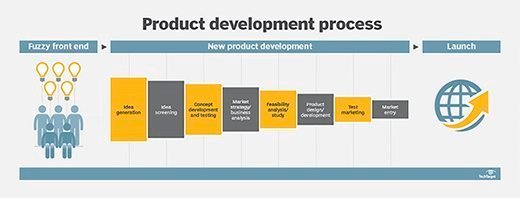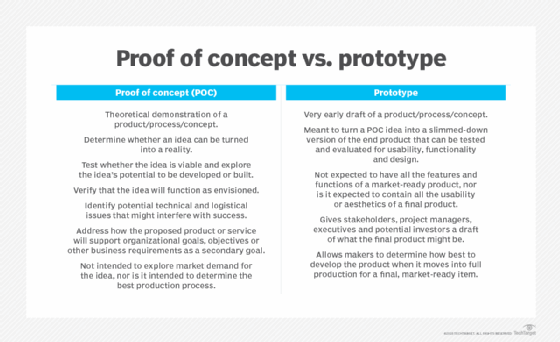product development (new product development)
What is product development?
Product development -- also called new product management -- is a series of steps that includes the conceptualization, design, development and marketing of newly created or rebranded goods and services. Product development includes a product's entire journey, from the initial idea to its market release and later.
The objective of new product development (NPD) from a business standpoint is to satisfy consumer demand to cultivate, maintain and increase a company's market share. From a customer standpoint, it's to ensure a product's value as a quality good or service.
Not every product will appeal to every customer or client base, so defining the target market for a product is a critical step that must take place early in the product development process. Organizations should conduct quantitative market research at all phases of the design process, including before the product or service is conceived, while the product is being designed, and after the product has been launched.
Some organizations have product development centers that make products. For example, Alphabet Inc., Google's parent company, launched a product development center in Nairobi, Kenya, to position itself to serve a growing base of internet users.

Product development frameworks
Although product development is creative, it requires a systematic approach to guide the processes required to develop, test and get new products to market. Organizations such as the Product Development and Management Association as well as the Product Development Institute help businesses select the best development framework for a new product or service. This framework helps structure the actual development of the product.
Development frameworks, such as the fuzzy front end (FFE) approach, define the steps that should be followed early in the development process, but leave it up to the product development team to decide in which order the steps make the most sense for the specific product that's being developed. The five elements of FFE product development are as follows:
- Identification of design criteria. Brainstorming exercises are used to identify possible new products.
- Idea analysis. A closer evaluation of the product concept includes market research and concept studies to determine if the idea is feasible and within a business context that's relevant to the company or to the consumer.
- Concept genesis. This involves turning an identified market opportunity into a tangible concept.
- Prototyping. A rapid prototype for a product concept is created.
- Product development. This is the actual creation of the product.
Other frameworks, such as design thinking, have iterative steps that are designed to be followed in a particular order to promote creativity and collaboration. The five steps of design thinking are as follows:
- Empathize. Learn more about a problem from multiple perspectives.
- Define. Identify the scope and true nature of the problem.
- Ideate. Brainstorm solutions to the problem.
- Prototype. Weed out unworkable or impractical solutions.
- Test. Solicit feedback.
Who is involved in the product development process?
One or more product managers typically oversee and coordinate product development activities. However, these tasks are typically collaborative and involve multiple teams working in tandem throughout an organization.
The people and groups involved in product development include the following:
- Product management. Product managers keep tabs on each team's progress towards achieving a final product and ensure they're operating on schedule. They draft a product roadmap as well as define the expectations and deliverables for the different product teams based on the roadmap. They then coordinate with the teams and people involved to ensure there are no problems or bottlenecks.
- Engineering. This is the most technical team involved. Engineers have the development skills needed for product development. If the new product is software, the engineers must have programming and testing skills as well as knowledge of development frameworks, such as Agile.
- Design. These tasks can overlap with engineering duties. Design professionals typically handle prototyping the new product and identifying user experience issues.
- Sales and marketing. These professionals do market research and analysis to gauge customer interest in the product under development. They're responsible for conveying this information to the other teams.
- Stakeholders. There are people and groups outside the organization that need to be updated on the development of a new product and might even have to approve it before it's launched. Such stakeholders include board members, investors, contractors, manufacturers, regulatory bodies and government agencies.
How to create a product development plan
How product development is done varies depending on the organization creating it. However, a general plan should include the following steps:
- Identify a product need and business case. Using practices such as test marketing and surveys, organizations can gauge interest in a product. This ensures the product has a strong reason to be created given the business model it's based on.
- Create a product vision. This covers determining the purpose of the product, what it does, who it's for and what the product design is. Having these details in place also determines the scope of the project and helps project managers craft the guiding principles for the work.
- Draft a roadmap. Once the project has been envisioned conceptually, an actual roadmap or detailed plan of action can be created. The roadmap aids in identifying what goals should be met when. Implementation teams create schedules, break down significant portions of the project into sprints and generate iterations of the product.
- Implement the roadmap. With a roadmap in hand, iterations of the product can be made, reviewed and improved upon. This identifies weak areas of the product as well as helps development teams fix and improve it.
- Continue with development and assessments. Development teams work on enhancements and changes to the product. In this step, customer feedback is gathered to improve the product based on customer input.
Stakeholder input should also be gathered and included in these steps to ensure their needs and requirements are being met.
New product development stages
The new product development process consists of the following stages:
Idea generation
The continuous and systematic quest for new opportunities includes updating or changing an existing product. The goal is to generate ideas for new products or services -- or improvements to products or services -- that address a gap in the market.
Idea screening
This step weeds out flawed or less desirable new product ideas through objective consideration, early testing and feedback from consumers and other stakeholders.
Concept development and testing
The product concept and functionality are tested on a customer base. Further development of the concept is done based on the feedback. For example, at this stage in car manufacturing, developers create concept vehicles out of clay that are shown at auto shows to elicit consumer feedback.
Market strategy and business analysis
The optimal way to market and sell a product or service is determined. It might vary depending on if it's a new market or an existing one for the company involved. Market strategy is comprised of the four Ps of marketing: product, price, promotion and place.
- Product. A service or good is designed to satisfy the demand of a target audience.
- Price. Pricing decisions affect everything, including profit margins, supply and demand, and market strategy.
- Promotion. This step involves presenting the product or service to the target audience with the aim of increasing demand and illustrating the product's value proposition. It includes advertisements, public relations and marketing campaigns.
- Place. Not all transactions are online. However, in the digital economy, customers are often engaged and converted on the internet. Products can be provided in a traditional brick-and-mortar business setting, online only or with an omnichannel approach. This is especially true if the targeted potential customers are to become actual customers.
Feasibility study
Information critical to a product's success is gathered. This entails organizing groups to beta test a version or prototype of the product and then evaluate their experience in a test panel. This feedback communicates target users' level of interest in the product. It also determines if the product in development has the potential to be attainable, viable and profitable.
Questions to be answered during feasibility analysis include the following:
- Do you have the labor and materials required?
- What's the price of production, delivery and promotion?
- Do you have access to the right distribution channels?
Technical design and roadmap
This stage integrates the results of the feasibility analyses and feedback into the product. It turns prototypes and concepts into workable market offerings, ironing out technical difficulties and prepping business groups for the product launch. This includes research and development, finance, marketing, production and operations. This step should also consist of creating a product roadmap that teams will follow to develop the new product.
Test marketing
Market testing validates the entire concept under development, from marketing angles to packaging, advertising and distribution. Test marketing typically involves offering the product to a random sample of the target market. By testing the entire package before launch, an organization can review the reception of its product before a full go-to-market strategy is made.
Market entry and commercialization
This is the stage in which the product is introduced to the target market. It's made available to everyone, and the product lifecycle begins. The life of the product is shaped by the reception of the target market, the competition and similar products it's up against, and subsequent enhancements to the product.
Product development is an ever evolving and fluid process. In some organizations, there's a dedicated startup team that researches and tests new products. Smaller organizations might outsource the NPD process to a separate design business. In larger organizations, the product manager is often the person in charge of product development. Regardless of which framework is used and who oversees new product development, this is just one aspect of the entire product lifecycle management.

Examples of product development
Product development is part of every industry and vertical market. The following examples depict how successful product development works in the two different industries.
Uber
Uber's unique backstory serves as an example of entrepreneurship and seizing the opportunity to develop a smartphone app when smartphones were in their infancy:
- Idea generation. In 2008, entrepreneurs Travis Kalanick and Garrett Camp began discussing the possibility of using a smartphone app to address the difficulty of getting a taxi ride on a snowy evening in Paris.
- Product technical design. Uber's app engineers used well-known programming languages, such as Python, Node.js and Java, for development.
- Concept testing. In 2010, the first Uber ride was requested and taken in San Francisco.
- Market entry. In December 2011, the app was rolled out internationally, beginning in Paris.
Roomba
IRobot's Roomba has an interesting development story. A 2016 New York Magazine article chronicled the early stages of the autonomous robotic vacuum's development:
- Idea generation. The idea for Roomba originated with a do-it-yourself Lego challenge when creator Joe Jones worked at the Massachusetts Institute of Technology Artificial Intelligence Lab. The challenge was to make something innovative from Legos.
- Idea screening. Jones showed initial concepts to companies -- Denning, Bissell, and Proctor & Gamble -- but they all declined to move forward.
- Product technical design. SC Johnson invested a couple million dollars in technical development for what would become the Roomba, but it then pulled out of the project because of internal changes at the company.
- Market entry. IRobot continued to fund the project. In September 2002, less than a year after SC Johnson withdrew financial support, iRobot launched the Roomba.
Product development vs. product management
Product development is a subset of product management. Product management is the broader category, encompassing product development. Product managers are responsible for each stage of a product's lifecycle. They generate the original concept or idea, manage its development, ensure it is adequately tested, and handle upgrades and new versions in accordance with changing customer needs. Product managers must have a range of hard skills, such as customer data analytics, as well as soft skills, such as leadership and communication.
Product development strategy focuses on the early stages of a product's lifecycle, from generating, developing and testing a concept up until it's launched in the market. Product development teams possess more hard skills than product managers. Development and testing, especially with new technology, requires a range of programming and design skills.
Product developer qualifications and expectations
Those pursuing product development roles, especially managerial roles, typically earn a bachelor's degree in fields such as sales or marketing. The day-to-day work includes overseeing the creation of a product development plan and subsequently the actual development. Product development team members typically have multiple roles, such as researching markets and consumer trends, designing and developing the product, and testing prototypes.
Because they fulfill multiple roles, product developers need diverse skill sets. Some hard skills aspiring product developers might want to have on their resumes include computer-aided design, programming languages, market research and data analysis expertise. Emerging technologies, such as artificial intelligence, are expected to create new roles in the product development field in the future.
Proofs of concept are essential for helping project managers outline the specific criteria a product needs to succeed. Learn how to create a proof of concept using our free templates.






